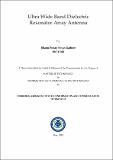| dc.contributor.advisor | Ghodgaonkar, Deepak | |
| dc.contributor.author | Rathore, Bhanu Pratap Singh | |
| dc.date.accessioned | 2017-06-10T14:42:58Z | |
| dc.date.available | 2017-06-10T14:42:58Z | |
| dc.date.issued | 2015 | |
| dc.identifier.citation | Rathore, Bhanu Pratap Singh (2015). Ultra wide band dielectric resonator array antenna. Dhirubhai Ambani Institute of Information and Communication Technology, viii, 41 p. (Acc.No: T00513) | |
| dc.identifier.uri | http://drsr.daiict.ac.in/handle/123456789/550 | |
| dc.description.abstract | Wireless communication play a imported role in our daily life. Present scenario of communication, all wired ones becoming as wireless. So, to achieve efficient and affordable communication in wireless technology, compact and efficient radiators are required. One of the efficient radiators is dielectric resonator antenna (DRA). Almost all the applied power will be lost in the radiated fields only, with this attractive feature DRAs become popular in wireless communication field at microwave frequencies.
At high frequency, patch and other metallic antennas have significant amount of energy losses due to conductor which cannot be negligible. Generally, dielectric Resonator antennas have more attractive features compared to general microstrip patch antennas because of absence of conductor material in DR antennas.
Dielectric resonating antenna uses a basic type of cavity resonator. It uses various combinations of dielectric materials, different and varied shapes of conducting material, various coupling techniques to produce the desired radiation pattern.
In this thesis, DR antenna array is designed with microstrip feed, using High Frequency
Simulation Software (HFSS) version 14.
The basic design of first antenna which was to be used as a test case for validation of results obtained by the antenna designed in software from a real data set. The second and third antenna which was designed was based on 6.2 GHz band. Its design parameters had two element array mechanisms with dielectric resonator incorporated in every single element separated with a calculated distance to achieve the requisite radiation pattern and desired gain. The only difference was third one was stacked Dielectric Resonator antenna for better coupling and bandwidth improvement purpose. In third arrangement higher permittivity material placed over lower permittivity
material because high permittivity material gives better coupling results and low permittivity material gives better Bandwidth. | |
| dc.publisher | Dhirubhai Ambani Institute of Information and Communication Technology | |
| dc.subject | Radio & TV communications equipment | |
| dc.subject | Standard Industrial Classification | |
| dc.subject | Electronic components | |
| dc.subject | Standard Industrial Classification | |
| dc.subject | Antennas | |
| dc.subject | Technology application | |
| dc.subject | Engineering design | |
| dc.classification.ddc | 621.384 RAT | |
| dc.title | Ultra wide band dielectric resonator array antenna | |
| dc.type | Dissertation | |
| dc.degree | M. Tech | |
| dc.student.id | 201311018 | |
| dc.accession.number | T00513 | |

